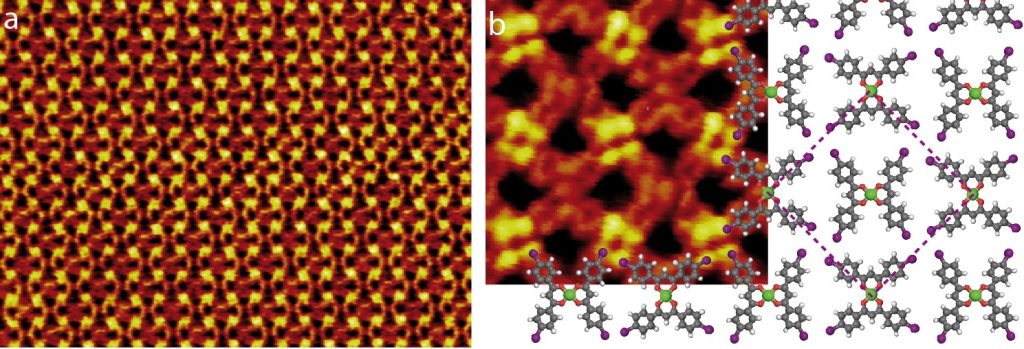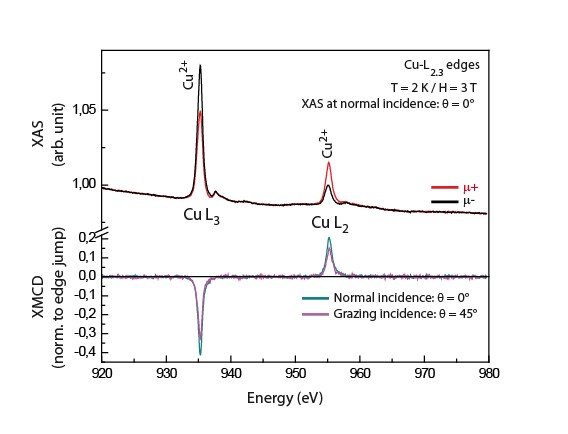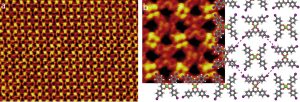Engineering novel nanomaterials with improved physical and chemical properties is a challenge in nanosciences. The fabrication of ordered arrays of magnetic building blocks has attracted scientific interest to create new devices for information processing, high-density information storage, and permanent magnets. We recently synthesized new molecular magnets based on the β-diketonato copper complex skeleton. In constrast with well-known porphyrine and phthalocyanine complexes, the central metal atom is not fully shielded by the complex skeleton. We used synchrotron radiation spectroscopies and scanning tunneling microscopy to probe the magnetic and structural properties of an organic film, composed of these β-diketonato complexes functionalized with iodine atoms (C30H18CuI4O4), deposited on a graphite surface.

Figure 1. STM image of the β-diketonato copper complex self-assembled on the graphite surface: (a) 31 × 23 nm2, Vs = 0.55 V, and It = 0.09 nA; (b) 6 × 6 nm2, Vs = 0.75 V, and It = 0.09 nA. The molecular arrangement model is superimposed onto the STM image in part b. The network unit cell is highlighted by a dashed purple square.
The molecular magnets are drop-casted onto a graphite surface. The scanning tunneling microscopy (STM) images in Figure 1a,b show that the molecular magnet self-assemble into a regular arrangement on the surface. The molecular network in Figure 1a,b is stabilized by halogen X4 synthons. The halogen X4 synthon is a motif composed of four molecular subunits (I−C). The model of the molecular network is superimposed on the high-resolution STM image (Figure 1b).

Figure 2. (Top) Experimental circular XAS (X-ray absorption spectroscopy) spectra (red and black spectra) of the Cu2+-complex film on HOPG, recorded at the Cu L2,3– edges at normal incidence (0° incidence angle). (bottom) XMCD spectra recorded at normal incidence (0°, green spectrum) and grazing incidence (45°, purple spectrum). XAS and XMCD measurements were performed at 2 K with an applied external magnetic field of 3 T.
After STM measurements, the sample is transferred in the synchrotron ultrahigh vacuum chamber. This leads to solvent evaporation. The magnetic properties of the organic film are then investigated using X-ray Magnetic Circular Dichroism (XMCD). Figure 2 reveals that the XMCD signal of the central molecular Cu2+ cation of the C30H18CuI4O4 complex is maximum at normal incidence (41%). This is 20% more than what was observed for a similar molecule with peripheral bromine atoms, instead of iodine atoms. STM revealed that these two β-diketonato complexes form different self-assemblies on the HOPG surface. One is also stabilized by X2 bromine synthons, whereas the other one is stabilized by X4 iodine synthons (Figure 1b). The molecular halogen substituents modify the molecular arrangement of the β-diketonato complexes on HOPG (Highly oriented pyrolytic graphite), which leads to an increase of the magnetic signal of the organic film when the molecular magnets are functionalized with iodine atoms.
These observations highlight the intriguing properties of molecular magnets at the atomic and molecular levels once deposited on nonmagnetic surfaces. The assessment of molecular magnet arrangement as well as their corresponding electronic and magnetic behaviors is essential for developing novel organic devices for applications in spintronics and nanomagnetism.
Collaboration:
-Université Paris-Saclay, CEA, CNRS, SPEC, F-91191 Gif sur Yvette, France; orcid.org/
-Synchrotron SOLEIL, F-91190 Saint-Aubin, France;
-Université de Toulouse, CEMES, CNRS UPR 8011, 31055 Toulouse, Cedex 4, France;
-European Synchrotron Radiation Facility, 38043 Grenoble, France
Reference:
“Enhanced Magnetic Properties in a Copper β-Diketonato Complex Film Stabilized by I···I Interactions on a Graphite Surface at 2 K for Molecular Spintronics.”
F. Silly, E. Vélez Fort, M. G. Silly, P. Ohresser, J. J. Bonvoisin
ACS Applied Nano Materials 7, 26455–26742 (2024).


